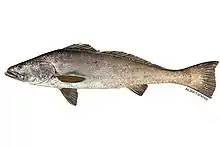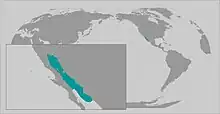Totoaba
The totoaba or totuava (Totoaba macdonaldi) is a species of marine fish, a very large member of the drum family Sciaenidae that is endemic to the Gulf of California in Mexico.[4] It is the only species in the genus Totoaba. Formerly abundant and subject to an intensive fishery, the totoaba has become rare, and is listed by the Convention on International Trade in Endangered Species of Wild Fauna and Flora under Appendix I.[2] It is also listed by the International Union for Conservation of Nature as vulnerable,[1] by NatureServe as critically imperiled[5] and under the U.S. Endangered Species Act as endangered.[4]
| Totoaba | |
|---|---|
 | |
| Scientific classification | |
| Domain: | Eukaryota |
| Kingdom: | Animalia |
| Phylum: | Chordata |
| Class: | Actinopterygii |
| Order: | Acanthuriformes |
| Family: | Sciaenidae |
| Genus: | Totoaba Villamar, 1980[3] |
| Species: | T. macdonaldi |
| Binomial name | |
| Totoaba macdonaldi (Gilbert, 1890) | |
 | |
| Synonyms | |
|
Cynoscion macdonaldi Gilbert, 1890 | |
Life cycle
The totoaba can grow up to 2 m (6.6 ft) in length and 100 kg (220 lb) in weight,[2] making it the largest species in the drum family,[4] together with the similar-sized Chinese bahaba (Bahaba taipingensis) and meagre (Argyrosomus regius).[6][7] The totoabas' diet consists of finned fish and crustaceans. Individuals may live up to 15 years, but sexual maturity is usually not reached until the fish are 6–7 years old. As totoabas spawn only once a year, population growth is slow, with a minimum population doubling time of 4.5 to 15 years.[2] The totoaba spawn in the Colorado River Delta, which also serves as a nursery for the young fish.[1]
The totoaba population is found in two distinct groups. Larval and juvenile stages occupy the Colorado delta, while the adult breeding population lives for most of the year in deeper water towards the middle of the Gulf of California. The adult population migrates to the Colorado delta in April and May to spawn. One-year-old totoabas are metabolically most efficient in brackish water of about 20 parts per thousand (ppt) salinity, a level that occurred naturally in the delta before the diversion of water from the river that occurred in the middle of the 20th century.[8]
Threats
The diversion of water from the Colorado River within the United States leaves little or no fresh water to reach the delta, greatly altering the environment in the delta, and the salinity of the upper Sea of Cortez. The flow of fresh water to the mouth of the Colorado since the completion of the Hoover and Glen Canyon dams has been only about 4% of the average flow during the period from 1910 to 1920. This is considered to be a major cause of the depletion of the totoaba population.[8][9][10][11] With the loss of the freshwater flow from the river, salinity in the delta is usually 35 ppt or higher.[8]
Poaching
Another threat to the totoaba is from human poaching: the swim bladder is a valuable commodity, as it is considered a delicacy in Chinese cuisine;[12] the meat is also sought-after for making soups. It can fetch high prices – 200 bladders may be sold for $3.6 million at 2013 prices – as it is erroneously believed by many Chinese to be a treatment for fertility, circulatory, and skin problems.[13][14] The swim bladders are often smuggled to Hong Kong where they are illegal, but import screenings are lax, and from there they are sometimes forwarded to the Chinese mainland where import screenings are stricter.[15] This trade once focused on the Chinese bahaba, but as its population became depleted, the trade shifted to the related totoaba.[16][17] The illegal totoaba fishery also threatens the vaquita, a critically endangered porpoise endemic to the northern Gulf of California that appears to be doomed to extinction unless the setting of gillnets in its habitat can be halted.[18]
Conservation
It has been illegal to catch totoaba since 1975 when it was placed on the Mexican Endangered Species List.[1] In 1976 it was added to CITES Appendix I and in 1979 it was placed on the US Endangered Species List.[1]
On 16 April 2015, Enrique Peña Nieto, the President of Mexico, announced a program of rescue and conservation of the vaquita and the totoaba, including closures and financial support to fishermen in the area.[19] This closure is necessary as they were still caught as a bycatch in the legal fishery for other species.[1] Some commentators believe the measures fall short of what is needed to save the vaquita.[20]
The Chinese trade in totoaba swim bladders has been a primary reason for its decline.[21] Despite being illegal, this trade often happened quite openly and traders reported being warned before checks by Chinese authorities, allowing them to hide the swim bladders.[22] More recently, both Mexican and Chinese authorities have tightened checks and performed raids, resulting in large confiscations and several arrests.[23][24][25]
The totoaba is suitable for fish farming due to the relative ease of breeding it in captivity and its high growth rate.[16][26] Although this mainly is done to supply the food market,[26] tens of thousands of totoaba hatched in captivity have been released into the wild in an attempt to save the species.[27]
Commercial trade

Commercial fishing for totoaba began in the 1920s. The catch reached 2,000 t (2,200 short tons) in 1943, but had fallen to only 50 t (55 short tons) in 1975, when Mexico protected the totoaba and banned the fishery. Anecdotal evidence suggests that totoabas were very abundant prior to the start of the commercial fishery, but no hard evidence now indicates natural population size. Recent studies indicate that the totoaba population has stabilized at a low level, perhaps a bit larger than when the commercial fishery was banned in 1975. Totoabas are still caught as bycatch in fishing for other finned fish and for shrimp, and in illegal fishing for totoaba directly. Some totoabas are illegally exported to the United States, often misidentified as white seabass.[8][9][10]
The government of Baja California has authorized commercial raising of totoaba in fish farms.[28][29] Although now done at a relatively large scale by private fish farms,[27] much of the initial research in the captive keeping, breeding and raising of totoaba was done at the Autonomous University of Baja California.[26]
References
- Cisneros-Mata, M.Á., True, C., Enriquez-Paredes, L.M., Sadovy, Y. & Liu, M. (2021). "Totoaba macdonaldi". The IUCN Red List of Threatened Species. IUCN. 2021: e.T22003A2780880. doi:10.2305/IUCN.UK.2021-2.RLTS.T22003A2780880.en. Retrieved 4 February 2023.
{{cite journal}}: CS1 maint: multiple names: authors list (link) - Froese, Rainer; Pauly, Daniel (eds.) (2021). "Totoaba macdonaldi" in FishBase. May 2021 version.
- Alejandro Villamar (1980). "Totoaba, un nuevo género de la familia Sciaenidae del Golfo de California, México (Pisces: Teleostei)" (PDF). Anales de la Escuela Nacional de Ciencias Biológicas, México (in Spanish). 23 (1/4): 129–133.
- "Totoaba (Totoaba macdonaldi)". NOAA Office of Protected Resources. NOAA. 5 December 2012. Archived from the original on 29 January 2016. Retrieved 19 August 2014.
- NatureServe (3 February 2023). "Totoaba macdonaldi". NatureServe Network Biodiversity Location Data accessed through NatureServe Explorer. Arlington, Virginia: NatureServe. Retrieved 3 February 2023.
- Froese, Rainer; Pauly, Daniel (eds.) (2019). "Bahaba taipingensis" in FishBase. May 2019 version.
- Froese, Rainer; Pauly, Daniel (eds.) (2022). "Argyrosomus regius" in FishBase. May 2022 version.
- Review of CITES Appendixes Based on Resolution Conf. 9.24 (Rev.) Totoaba macdonaldi (Mexican seabass) Archived 2007-09-27 at the Wayback Machine
- "Sonoran Desert Coastal Conservation - Totoaba". Retrieved 11 July 2007
- Monterey Bay Aquarium Seafood Watch - Totoaba Archived 2007-08-11 at the Wayback Machine
- "Earstones Tell Fishes' Tale in Colorado River Estuary". ScienceDaily. 15 June 2004. Retrieved 10 June 2008.
- Urbina, Ian (23 July 2020). "Unmasking China's Invisible Fleet in North Korean Waters". CBC.
- Morell, V. (1 February 2017). "World's most endangered marine mammal down to 30 individuals". Science. doi:10.1126/science.aal0692.
- Stickney, R. (25 April 2013) "Multi-Million Dollar Fish Bladder Factory Uncovered in Calexico". KNSD.
- Guilford, G. (25 August 2015). "How China's fish bladder investment craze is wiping out species on the other side of the planet". Quartz. Retrieved 18 May 2019.
- Juarez, Lorenzo M.; Pablo A. Konietzko; and Michael H. Schwarz (15 December 2016). "Totoaba Aquaculture and Conservation: Hope for an Endangered Fish from Mexico's Sea of Cortez". World Aquaculture Magazine. Retrieved 18 May 2019.
- Hance, J. (11 January 2016). "China's craze for 'aquatic cocaine' is pushing two species into oblivion". The Guardian. Retrieved 18 May 2019.
- Joyce, C. (9 February 2016). "Chinese Taste For Fish Bladder Threatens Rare Porpoise In Mexico". NPR. Retrieved 6 February 2017.
- "U.S. supports Mexico's efforts to save the vaquita". El Universal. 16 April 2015.
- Smith, Zak (16 March 2015). "This Week in Whales Focus: The Call to Ban Mexican Seafood Products Gets Louder After Mexico Announces its Plan for Vaquita Extinction". National Resources Defense Council.
- Scheer, Robert (25 October 2019). "The Drug Trade Isn't Just Killing People, but the Planet Itself". truthdig. Retrieved 3 November 2019.
- Carrington, D. (16 May 2017). "Chinese appetite for totoaba fish bladder kills off rare porpoise". The Guardian. Retrieved 18 May 2019.
- Cannon, J.C. (1 May 2018). "More than 800 totoaba swim bladders confiscated by Mexican authorities in smuggling busts". Mongobay. Retrieved 18 May 2019.
- Dasgupta, S. (29 December 2018). "China seizes totoaba swim bladders worth $26 million, arrests 16". Mongobay. Retrieved 18 May 2019.
- BBC News (7 March 2019). "China accuses 11 of smuggling totoaba swim fish bladder". Retrieved 18 May 2019.
- Dodd, Q. (27 November 2017). "Saving the totoaba for fun and profit". Hatchery International. Retrieved 18 May 2019.
- Kiy, R. (5 July 2018). "Fourth Release of Totoaba in Baja California Sur: A Unique Alliance Between Government and the Private Sector to Protect a Species at Risk of Extinction". Business Wire. Retrieved 18 May 2019.
- Penuelas Alarid, Bernardo (31 October 2010). "Comercializarán totoaba criada en cautiverio". El Mexicano (in Spanish). Retrieved 4 September 2011.
- Santos Malagón, Sac-Nicté (6 September 2010). "Buscan hacer de la totoaba un producto distintivo". La Voz de la Frontera (in Spanish). Retrieved 4 September 2011.
External links
![]() Media related to Totoaba macdonaldi at Wikimedia Commons
Media related to Totoaba macdonaldi at Wikimedia Commons
- Totoaba. Mexfish.com.
- "Long live the totoaba". sanfelipe.com.
- History of the Totoaba. Mexfish.com.
- Gene Kira, "Sea of Cortez Fishing Gulf of California: The near-extinction of the species came with stunning rapidity". Western Outdoor News.
